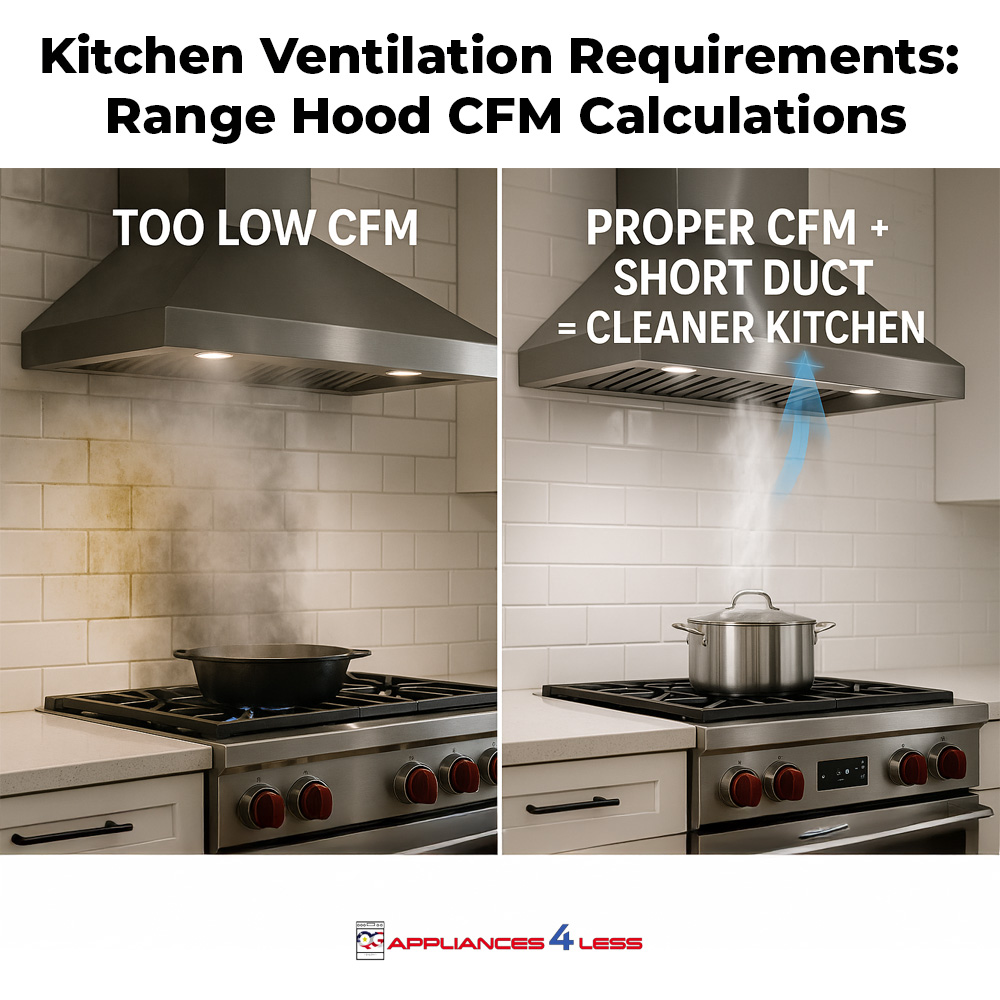Kitchen Ventilation Requirements: Range Hood CFM Calculations
Kitchen ventilation requirements are often overlooked aspects of creating a functional and comfortable cooking space. Whether you’re upgrading your stove, installing a new oven, or remodeling your kitchen entirely, proper ventilation ensures your space stays clean, fresh, and safe.
At A4L, we help homeowners, renters, and families choose appliances that make their kitchens more efficient and enjoyable from refrigerators and dishwashers to washers, dryers, microwaves, ovens, and stoves (both gas and induction). When it comes to cooking, your range hood plays a major role in keeping air quality high and maintaining the look and feel of your home.

Why Kitchen Ventilation Matters
Cooking releases smoke, grease, steam, and lingering odors that can build up quickly without proper airflow. Over time, this can lead to sticky residue on cabinets, unpleasant smells, and even poor indoor air quality. A good range hood helps remove these airborne particles while improving temperature balance in your kitchen.
The strength of your range hood is measured in CFM (cubic feet per minute) a rating that shows how much air the fan can move. Understanding range hood CFM calculations will help you choose the right ventilation power for your kitchen setup
How to Calculate the Right Range Hood CFM
The right CFM depends on the type of stove you have and how often you cook. For most home kitchens, here’s a simple way to estimate:
- For electric stoves, you’ll want at least 100 CFM for every 10 inches of stove width. So, a 30-inch electric range would need a hood with around 300 CFM.
- For gas stoves, you’ll need a bit more power because they produce more heat. Multiply the total BTUs of your burners by 0.1 to estimate the CFM. For example, if your range outputs 50,000 BTUs, you’ll need a hood with about 500 CFM.
If you frequently use high-heat cooking methods like frying, searing, or wok cooking—consider going higher than the minimum kitchen ventilation requirements for extra airflow.
Choosing the Right Ventilation for Your Kitchen
Range hoods come in a variety of styles to match any kitchen design. Wall-mounted hoods make a statement, while under-cabinet models save space. Island hoods are perfect for open-concept kitchens, and downdraft systems are great for minimalist layouts.
Pairing your range hood ventilation with the right stove or cooktop makes all the difference. At A4L, we offer both gas and induction stoves that work beautifully with high-performance hoods. You can also complete your setup with matching ovens, microwaves, and refrigerators for a cohesive, modern look.
Visit A4L for Kitchen Appliances and Expertise
When planning your next kitchen upgrade, don’t overlook kitchen ventilation requirements. Our team at A4L can help you calculate the ideal range hood CFM for your cooking style and space, ensuring your kitchen remains both stylish and practical.
We carry a wide selection of affordable appliances for every room in your home—whether you’re upgrading your kitchen, laundry area, or both. Visit your nearest A4L store today to explore top brands, expert advice, and unbeatable prices.
Kitchen ventilation requirements are essential to maintaining air quality, comfort, and cleanliness in your home. By understanding range hood CFM calculations, you can choose the right ventilation system to match your cooking habits and appliance setup. Stop by A4L to learn more about kitchen ventilation and discover high-quality appliances designed for modern homes.
Kitchen ventilation requirements, Range hood CFM calculations, Range hood ventilation, Kitchen appliance store, Home appliance upgrades